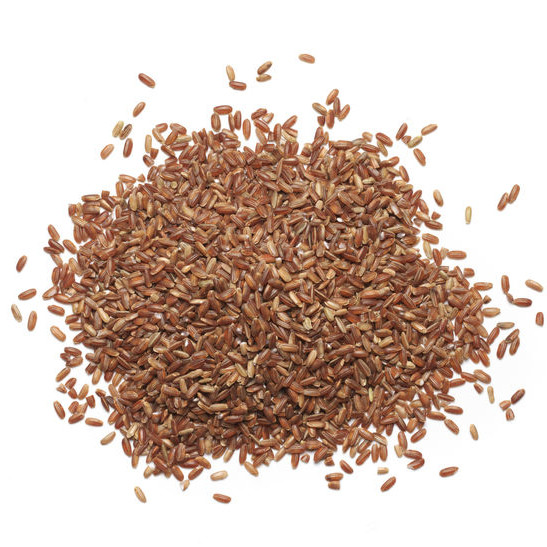
Brown Rice Flour
What is Brown Rice Flour?
Brown rice flour is obtained from dehulled whole-grain brown rice (Oryza sativa). It is gluten-free and a nutritious alternative to wheat flour. Brown rice is a rich source of:
- Fiber
- Vitamins E and B
- ?-orynazol
- Other phenolic compounds
Origin
Rice was first cultivated in southern China about 6000 BC. It soon spread into Vietnam, Thailand and India.1 Currently, China and India account for 50% of rice production worldwide.2 In the US, rice is primarily produced in California, Louisiana, and Arkansas.
Due to its hard texture and dark color, brown rice is mainly ground to flour for making cakes and breads.
Composition and Nutrition
Brown rice as flour (100 g) is composed of:3
| Component | Amount |
| Carbohydrate | 77.5 g |
| Protein | 7.5 g |
| Fiber, total dietary | 5 g |
| Total lipids | 2.5 g |
| Iron | 1.8 mg |
| Sodium | 12 mg |
Brown rice as flour provides 3.5 kcal per 100 g.3 The nutritional components in brown rice are primarily present in the germ and bran layers. Compared to white rice flour, this rice flour contains unique bioactive compounds such as antioxidants, polyphenols, minerals, vitamins and dietary fiber.4 Brown rice may help in reducing the risk of many chronic diseases, including type-2 diabetes, cardiovascular disease or cancer.4
Function
Brown rice flour is gluten-free, so it can replace wheat or other gluten-containing flours such as amaranth, buckwheat, corn, millet, quinoa, sorghum or teff.
Successful baking with brown rice flour composites requires incorporation of starches and gums to strengthen the dough network. The presence of fiber in in this ingredient affects the water absorption of flour and starch gelatinization.
Application
Brown rice flour is used as a partial replacement to wheat flour in bread, muffins and cookies.5
- Replacement of this ingredient in bread traditionally made with wheat flour weakens the gluten network, reduces loaf volume and hardens its texture.
- The addition of transglutaminase enzyme or hydrocolloids such as potato starch, hydroxypropyl Methylcellulose (HPMC), xanthan or other gums can help increase the volume of bread and its capacity to better hold CO2 gas.
- Using pre-fermented flour or sourdough can also be used to improve the rheological properties of doughs made with this type of flour or its composites.
FDA Regulation
Brown rice is regulated by FDA in regard to good manufacturing practices, hazard analysis, and risk-based preventive controls in the article 21CFR117.5.6
Whole grain claims and associated health benefits are listed in 21CFR102.5(b).7
References
- Rice history: where does rice come from? South-east Asia. https://quatr.us/china/rice-come-china.htm. Accessed Nov 25. 2019.
- Muthayya, S., Sugimoto, J. D., Montgomery, S., and Maberly, G. F. An overview of global rice production, supply, trade, and consumption. Annals of the new york Academy of Sciences, 1324 (2014): 7-14.
- Brown rice flour. https://fdc.nal.usda.gov/fdc-app.html#/food-details/396943/nutrients. Accessed Nov 25. 2019.
- Mir, S.A., Bosco, S.J.D., Shah, M.A., Mir, M.M., and Sunooj, K.V., Variety difference in quality characteristics, antioxidant properties and mineral composition of brown rice. Journal of Food Measurement and Characterization. 10 (2016): 177-184.
- Schober, T. J., O’Brien, C. M., McCarthy, D., Darnedde, A., and Arendt, E. K. Influence of gluten-free flour mixes and fat powders on the quality of gluten-free biscuits. European Food Research and Technology. 216 (2003): 369–376.
- “CFR – Code of Federal Regulations 21CFR117.5”. Accessdata.fda.gov. April 01. 2019. https://www.accessdata.fda.gov/scripts/cdrh/cfdocs/cfCFR/CFRSearch.cfm?fr=117.5. Accessed Nov 25. 2019.
- “CFR – Code of Federal Regulations 21CFR102.5(b)”. Accessdata.fda.gov. April 01. 2019. https://www.accessdata.fda.gov/scripts/cdrh/cfdocs/cfcfr/CFRSearch.cfm?fr=102.5. Accessed Nov. 27. 2019

